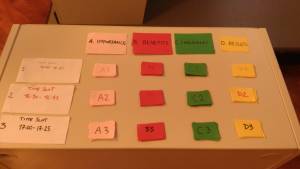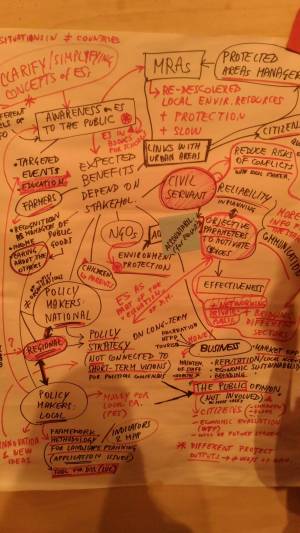Table of Contents
Methodology
Participatory approaches
Participatory approaches: the World Cafe
 Communicating the relevance of ecosystem services (ES) for Alpine local and regional management as well as the challenges connected to implementation, are objectives of the AlpES transnational project. While the ES approach exemplifies an approach to recognise services of nature to humans, stakeholders hold different knowledge and understandings about its possible uses, and may adopt different approaches to implement it in their territories or regions.
Communicating the relevance of ecosystem services (ES) for Alpine local and regional management as well as the challenges connected to implementation, are objectives of the AlpES transnational project. While the ES approach exemplifies an approach to recognise services of nature to humans, stakeholders hold different knowledge and understandings about its possible uses, and may adopt different approaches to implement it in their territories or regions.
<font 14px/14px;;inherit;;inherit>AlpES partners took advantage of the mid-term partner meeting in Venice, in November 2017, to share perspectives on the benefits and challenges of the approach, feedback local and regional stakeholders provided during the project’s stakeholder involvement activities, as well as suggest uses of the results of the AlpES project past its conclusion. To do this, the Veneto team (University of Padova and Etifor, a Spin-off of the University of Padova), organised a two-hour world café for project partners and local stakeholders to propose their own perspectives. This technique could be proposed regionally or locally to address discussion of ecosystem services more in-depth.</font>
The discussions were divided into four groups, and highlighted perspectives from a diversity of stakeholders. The full report is available at the Etifor website.
1. What did the stakeholders from the pilot test regions emphasize as important during their discussions with the AlpES interviewers?
In the pilot test regions, stakeholders emphasised several observations made by stakeholders. These included the need to become familiar with the concept to address complexity, applicability and usability of the concept and recognise bundles of services rather than single services, as well as scenarios and trend over time.
2. What are the benefits that different stakeholders expect to obtain from the implementation of the ES approach?
 Diverse benefits were highlighted for diverse stakeholders. For example, civil servants highlighted how the ES approach can help improve both the network and dialogue between public and private actors by providing methodologies and tools for decision-making. The possibility to use a long-term perspective, the introduction of new ideas to catalyse innovation, the creation of additional income opportunities (e.g. through payments for ecosystem services) and the opportunity to use it as an awareness raising approach, were presented among a range of other options..
Diverse benefits were highlighted for diverse stakeholders. For example, civil servants highlighted how the ES approach can help improve both the network and dialogue between public and private actors by providing methodologies and tools for decision-making. The possibility to use a long-term perspective, the introduction of new ideas to catalyse innovation, the creation of additional income opportunities (e.g. through payments for ecosystem services) and the opportunity to use it as an awareness raising approach, were presented among a range of other options..
3. What are the challenges that different stakeholders might face from the implementation of the ES approach?
The challenges that different stakeholders might face from the implementation of the ES approach were different than those generally connected to the ES approach. These included issues such as effective communication, availability of resources and know-how related to the application, implementation and evaluation of the ES approach. They also include availability of concrete experiences at the local level and data, as well as the need for dialogue to clarify common definitions and methodologies. A series of questions captured concerns about building a resilient governance vision: How do ES change on time? How is it possible to make long-term scenarios? How can participatory approaches be adopted? How can we combine the ES concepts with other nature-based concepts?
4. How can the results of the project be used after the conclusion of the project, by the different categories of stakeholders, i.e., public, private and research institutions?
Different perspectives where considered for addressing uses of project results. For public stakeholders, the ES assessment and mapping could inform and drive decision making and investment priorities as well as facilitate the development of new policies and regulations including the ES concept. AlpES results could also be used for providing internal training to public entities. For private stakeholders, the results could help developing market based instruments or contributing to local development. as well as assess impacts associated with development activities and investments, set-up specific mitigation or compensation measures as well as prevent and manage ES trade-offs.
Participatory approaches: understanding ecosystem services at the community level in northeastern Italy
<font 14px/14px;;inherit;;inherit>Stakeholders hold different knowledge and understandings about ecosystem services and ways to best secure their valorisation and management. Different understandings can thus lead to contextually specific implementation in territories and regions.</font>
<font 14px/14px;;inherit;;inherit>In the Veneto Region, Northeastern Italy, the Region collaborated with the local development agency, the Local Action Group (LAG) Alto Bellunese, to find ways to be communicate the term ‘ecosystem services’ and promote the creation of mechanisms for Payments for Ecosystem Services in the local context.</font>
<font 14px/14px;;inherit;;inherit>With the technical support of Etifor, the Veneto Region developed a stepwise process for communicating the ecosystem services concept in the territory:</font>
- Presentation of the ecosystem services concept to a key stakeholder in the area
- <font 14px/arial,helvetica,sans-serif;;inherit;;inherit>Identification of the target area for communication and dissemination of the concept</font>
- <font 14px/arial,helvetica,sans-serif;;inherit;;inherit>Identification of ecosystem services of interest for development purposes</font>
- Organisation of community workshops by selected ecosystem services in the target area
- Assessment of results and planning of future development projects in the area
Presentation of the ecosystem services concept
<font 14px/14px;;inherit;;inherit>In order to introduce, discuss, and select the ecosystem services of interest for the area, a technical meeting between the Region and the local development agency was organised. Two ecosystem services were selected for further communication in the local area. These are:</font>
- <font 14px/14px;;inherit;;inherit>Biomass production</font>
- <font 14px/14px;;inherit;;inherit>Outdoor recreation activities</font>
<font 14px/14px;;inherit;;inherit>The area identified within the LAG to work on was the Zoldo Valley, located in the heart of the Dolomites, in the Province of Belluno, Veneto.</font>
Organisation of participatory workshops
<font 14px/14px;;inherit;;inherit>Follow me, there’s a path in the woods: </font><font 14px/14px;;black;;inherit>Through a theatre performance, threading through the cultural, historical and literary values of forests, the first series of three meetings was introduced in Zoldo. The key area of interest was the valorization of local wild forest products and local farm productions as a way to stem land fragmentation in the valley</font> .
<font 14px/14px;;inherit;;inherit>Is it the community that has to serve tourism or tourism that has to serve the community? </font><font 14px/14px;;inherit;;inherit>With this question,</font><font 14px/14px;;inherit;;inherit>the</font><font 14px/14px;;inherit;;inherit>second</font>series of workshops focused <font 14px/14px;;inherit;;inherit>on recreational services. First, the local community was asked to respond to the question: ‘Tourism in Val di Zoldo is…” Second, the meetings brought together stakeholders involved in tourism, including the provincial Destination Management Organisation, the local tourism consortium, the local development agency, the mayor of the valley and the regional project partner. Third, two participatory meetings were held for the community and the local operators to identify the needs of the tourism sector in the area, and to reflect on the resources locally available to construct a tourism product.</font>
Assessment of results and planning of future development projects
By promoting and attending all the events, the local development agency was able to draw on key issues and propose two cooperation projects promoting local public mobility and the valorisation of a site. These projects are to be developed together with the municipality of the valley. In terms of tourism, the AlpES project is to further investigate the potential to adopt payment-based mechanisms to support the valorisation of the local site.
Discussion
Communication of the ecosystem services concepts should start from the translation into terms that resonate with local understandings of territory, development, identity, and culture. In the case of biomass production, the community was first asked to reflect on what the forest meant to them from a cultural and historical point of view, and how their forest/grassland resources could support local development. In the case of ‘recreational service’, it was translated into a concept more closely aligned with tourism’s best practices, which are currently associated with the concepts of destination organisation, management and marketing. In this case, tourism was described as a common and territorial good that can be cultivated by the community to support local development.
Projects that address this type of Output
* ALP FFIRS__ * capacities__ * comunis__ * innocite__ * newfor__ * PermaNET__ * sedalp__ * SHARE__ * silmas__
→ go to the list of outputs__